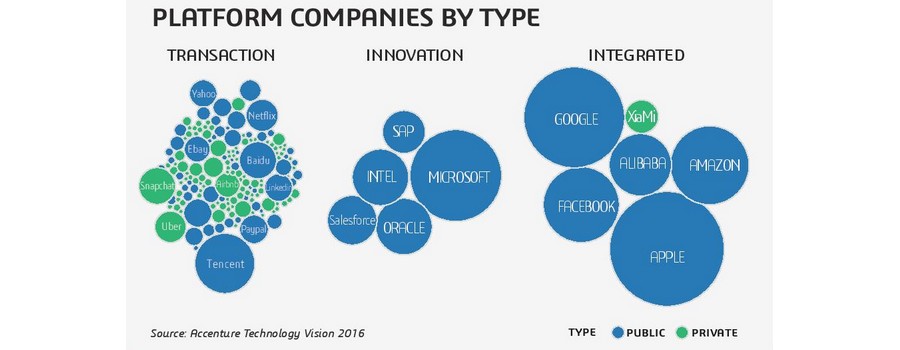THE RISE OF PLATFORM BUSINESS – How digital networks are changing competition
Blog: Apriso Blog
 Whether we have purchased a book through Amazon or watched videos on YouTube, most of us have used a digital platform – an online framework for social and marketplace interactions. From Alibaba to eBay to Google, platform dealings have become part of everyday life for consumers. Now businesses are creating these high-value exchange environments to facilitate interaction with one another and, in the process, a pivotal change in the way businesses compete.
Whether we have purchased a book through Amazon or watched videos on YouTube, most of us have used a digital platform – an online framework for social and marketplace interactions. From Alibaba to eBay to Google, platform dealings have become part of everyday life for consumers. Now businesses are creating these high-value exchange environments to facilitate interaction with one another and, in the process, a pivotal change in the way businesses compete.Only someone living without an internet connection on a remote island or deep in the jungle could have missed the digital platform revolution. From Uber’s well-publicized assault on taxicabs to Airbnb’s creation of an entirely new hospitality business, digital platforms have transformed many areas of daily life – and now they’re migrating from business-to-consumer (B2C) commerce and into the realm of business-to-business (B2B) interactions as well. Global consulting firm Accenture states in its “Technology Vision 2016” report, “unparalleled growth of the digital economy has put it on course to account for 25% of the world’s entire economy by 2020, up from 15% in 2005; Platform business models represent a fast-increasing proportion of the overall total.” “What we’re seeing is that the platform business model is a huge piece of how a lot of big companies are planning their futures,” said Michael Biltz, managing director of Accenture Technology Labs in San Jose, California, who advises firms on platform development. “Not all companies will create platforms themselves, but most firms are looking to carve out a nice meaty role within some of these new ecosystems that are just starting to be developed.”
B2C platforms such as Apple and Facebook have become a routine part of everyday life; but B2B platforms are less well known. Examples include Panoptix from Johnson Controls, a US firm that makes heating and air-conditioning equipment. Panoptix is an innovation platform that allows developers to write and sell apps for building management issues such as energy conservation and then sell them to users online. Meanwhile, an Australian bank launched a platform in Indonesia to help small businesses monitor their cash flows. While the online tools are free, the data gives the bank insights into which businesses might need its loans, as well as their creditworthiness. IDC Research, a Framingham, Massachusetts, market intelligence firm that specializes in technology, calls B2B platforms “Industry Collaborative Clouds,” to distinguish them from consumer-oriented platforms. Eric Newmark, program vice president for IDC’s Cloud, SaaS and Industry Cloud practice, estimates that these platforms now have revenue of between US$2 billion and US$4 billion a year, a tiny fraction of the income in the US$2.6 trillion market capitalization B2C platform economy. But he forecasts dramatic growth in B2B platforms over the next five to six years, reaching US$25 billion to US$30 billion annual turnover as companies scurry to reap the same benefits B2C companies are getting from platforms.

San Antonio-based Frost & Sullivan, another technology consultancy, is even more bullish about B2B platform commerce. It expects this business to reach US$6.7 trillion by 2020, double the amount of B2C business. Leading the charge are Chinese platform firms like Alibaba, which enables small manufacturers in China’s cities to reach outlying wholesalers and retailers without the need for brick-and-mortar stores. Whichever estimate you believe, it is undeniable that many companies are financing B2B platforms out of their balance 15sheets, without the need for the venture capital that fueled the growth of most B2C platforms. B2B platforms also can run profitably on a much smaller scale with hundreds, not millions, of users. That puts platforms within reach for even small companies to convert their existing pipelines to platform ecosystem.
Read the rest of this story here, on COMPASS, the 3DEXPERIENCE Magazine
Continue the conversation by joining our DELMIA Communities on SwYm. Membership is free.
Leave a Comment
You must be logged in to post a comment.







